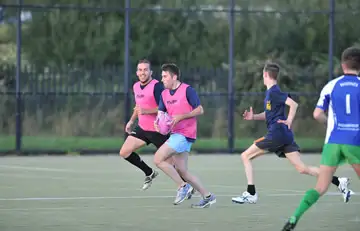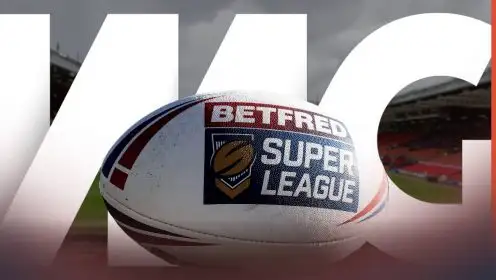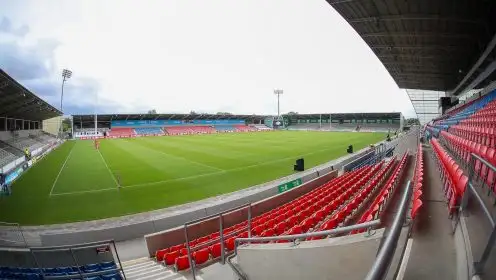Touching the void: Battle of the codes for control of touch

Rugby league and rugby union in the UK are involved in a fight for ownership of the sport of touch rugby, a key tool in the development of players.
Touch, known as both touch rugby and touch football in different parts of the world, was established in the 1960s in Australia. In its most simple form, it is rugby league without tackling or kicking, a limited-contact sport with a set of six that can be played by both sexes.
From its humble origins at the South Sydney Junior Rugby League Club, touch has spread around the globe and now has its own World Cups and international events.
While it has become a sport in its own right, it remains intrinsically linked with the rugby codes by its roots. And while it might not seem as popular as league or union, it is a social game which has worked wonders in attracting new players to both codes because it is easily accessible and caters for men and women of all abilities.
Across Australia and New Zealand it is common to see pick-up games of touch, along with organised competitions, take place at parks and ovals at all times of the day by those young and old.
From Shaun Johnson, to Matt Moylan and Benji Marshall, touch has had a long history of helping to create exciting and skilful players that go on to have successful professional rugby league careers. These NRL stars learnt and perfected their wares on the touch field before transplanting them into the 13-man code.
The likes of Johnson and Marshall have insisted they wouldn’t have had the careers they did without touch. Support for the sport and its influence on development exist in England as well.
Leeds Rhinos stalwart Rob Burrow, a player who’s game is built on skill, smarts and speed, not size and strength, recently emphasized the various benefits touch can offer.
“I think it’s a great game to get involved with,” Burrow said.
“It’s a team game, so there are a lot of chances to meet new people and get that feeling of being in a team environment which you can only feel if you get involved with it.
“That’s something which is especially good in Touch as it is open to anyone.
“As well as that, Play Touch Rugby League is a great way to improve your rugby skills and general fitness too, which can only benefit you in life.”
Some of the main differences of touch compared with rugby league and union is the duration of a match, the number of players and the method of tackling.
League and union matches consist of two 40-minute halves whereas a game of touch lasts 40 minutes in total, split into two 20-minute periods.
In touch you can only have six players on the field at any one time compared with 13 in League and 15 in union.
The third notable contrast between the three forms involves tackling – in touch, a player can tackle an opposing player by grabbing any part of their body, clothing and ball. Each team has six ‘touches’, instead of tackles, with the ball before a changeover of possession.
In league and union, players must either take an opponent to the ground or hold their opponent to prevent them from making any further ground as well as releasing the ball to a team-mate.
While both rugby codes emphasise physicality and contact, touch promotes speed, fitness and passing of the ball. The skills of the catch-pass, draw and pass, dummying and stepping are all honed on the touch field, making it a perfect way to safely introduce children and new participants to rugby.
In England both the RFL and the Rugby Football Union (RFU) have devised programmes to promote touch throughout the country.
The RFL’s scheme Play Touch Rugby League was established back in 2013 and started off with eight licensees awarded to individuals tasked with overseeing the programme in various areas.
From that starting point the RFL now has touch leagues and sessions up and down the country – from Billingham (North East) to Oxford – with 50 licensees and over 5000 registered participants.
In 2013, the RFU teamed up with sponsor O2 in their bid to grab a piece of the touch rugby pie.
Titled O2 Touch, it is pitched to be a fun way of improving general fitness as well allowing people to take part in games of touch – sessions are played to motivating music mixes.
There are leagues for people who wanted to be involved in a competitive environment – at present there are 17,500 registered players in over 321 centres.
Similar to Play Touch Rugby League, for people who haven’t played rugby before or don’t have the time to play every week, there is a ‘pitch up and play’ initiative.
While touch historically has a stronger connection to league than union, in the UK it is union that commands most sway in the sport.
But in Australia – the birthplace of touch – it is a different story. The NRL merged with touch football governing body Touch Australia Australia (TFA) three years ago and is set to reap the rewards.
As its own sport touch has gone from strength to strength down under in the past 50 years.
There are now more 400,000 registered members as well as another half a million children taking part in school programmes. Such is the growth of the sport that it now ranks among the top participant-based, organized sports in Australia.
Many people play touch instead of rugby league because it is fast, fun and largely devoid of injury. Males and females can also play it together, well into their 40s, 50s and even 60s, unlike in the more physically-demandeding arena of rugby league.
In four years Touch Australia hope to have more than a million participants involved, which highlights the dedication and passion Australians have for touch.
One key move was introduction of the annual National Touch League, which went a long way to promoting the game throughout Australia.
The competition was split up into different sections from under-20 to women’s leagues and it was devised in order to promote healthy competitions between all areas. Traditionally, Australian Capital Territory, Queensland and New South Wales have been regarded as the dominant touch states.
The National Championships, established by School Sport Australia, are another initiative, which has helped to drive participation, particularly among children.
Open to boys and girls from all states and split into an under-12 and under-15 section, it provides an arena for the best junior touch footballers to showcase their skills and possibly earn a place in the national youth squad.
The partnership between the NRL and the TFA, which began three years ago, was an inspired decision and has undoubtedly shone the spotlight firmly on touch football.
Be one in a million! Play @TouchFootyAus this Summer!
Registrations now open!
Visit https://t.co/vcsivZX3jL NRL?src=hash”>#NRL pic.twitter.com/QgGIKTW5Wr
“Most people who play Rugby League have all played touch and vice versa. I don’t know anyone who hasn’t played touch footy at lunch time at school,” Don Furner, the CEO of the Canberra Raiders, said.
“The move also opens the way for more females and juniors to play.
“The more people playing touch footy the more chance there is to go and play in the NRL.”
That possibility of taking up touch and eventually progressing to play in the NRL one day is a huge pull factor and is a move which could be hugely successful in this country.
If people playing touch in England knew there was a very real possibility they could one day be gracing the Super League, with a proper pathway established, then it is almost certain there would be a rise in the number of participants.
In Australia, it is clear the potential of touch as a development tool has been fully recognized. One example is the recent success of the Australian women’s team in rugby sevens at the Rio Olympics, which won gold. Four members of the side have previously represented Australia in touch football.
Touch Football Australia chief executive officer Colm Maguire insists touch played a key part in developing those players.
“I thought the difference between the teams was the ability of our girls to see space, throw that long pass to open space, and have players run into the hole,” Maguire said.
“Our sport is different to a lot of others in being an evasion game. So our girls are always looking for space. They are always looking to score.
“They develop an attacking mindset. Their high fitness level is another key element, and helps them to handle the workload.
“There will be a lot of people now talking about playing sevens football, but those girls (in the Australian team) wouldn’t play the way that they do if they hadn’t had their skill development in our game.”
In the UK there is often a debate about the quality of the coaching of young rugby players and their skills development. Are we bringing through enough talent? Do they do enough with the ball? Where will our next Jonathan Davies, our next Sean Long or Lee Briers come from? How can we produce our own Benji Marshalls and Jonathan Thurstons?
There is a focus today in rugby league in getting bigger and stronger, a drive towards more gym work and weight sessions than those with the ball. How are today’s players developing their footballing brain, the ability to know when to pass and to who?
The growth of touch rugby and its employment to refine these core skills is one way to achieve the end of producing more highly skilled players. Kids can be taught to tackle at a later stage – the ability to catch and pass, to play what is in front of you, is fundamental from the beginning.
The Antipodean method often uses touch football for children and in schools to drill in these basic skills before they take up organised rugby league with clubs and go from there.
In Australia touch is wedded to the hip of rugby league, but in England it is split into the competing camps of league and union. The RFL is ramping up its touch rugby program but the RFU already has a decent head start in the battle for hearts and minds.
If the RFU wins the war for touch, what will the end result be? It is hard to tell.
Both codes are seeking to produce better footballers, more skilled players who can be the best in the world. Both codes are also after expansion, after better engagement with their existing customers and converting new fans to their product.
At its core, touch can help do both.



